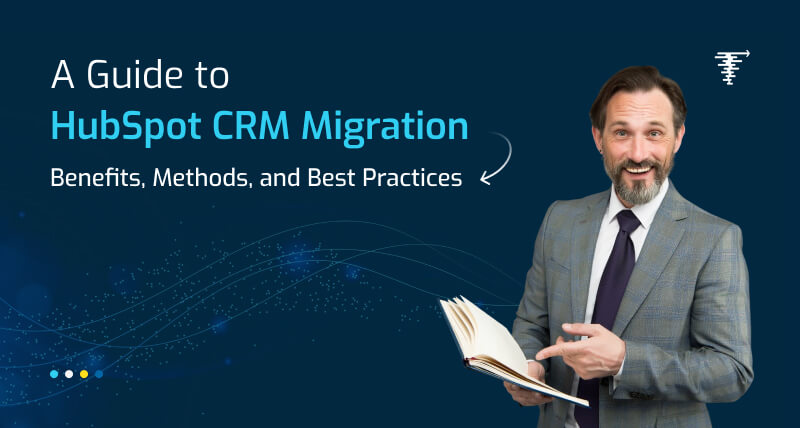

Did you know 91% of companies with 10+ employees use at least one CRM tool to manage customer relationships? However, most organisations struggle with outdated procedures, inefficiencies, and convoluted CRMs slowing down business growth. And if you are one of them too, then it's time to make a wise decision and shift your website to HubSpot - a powerful, intuitive, and expandable solution specifically created to address today's business needs.
And it's no wonder migrating to a new CRM can overwhelm you, but can streamline processes, boost productivity, and fuel revenue growth.
Here in this guide, we'll take you through all that you would want to know about how to migrate to HubSpot CRM in the right way—without losing precious data or interrupting operations.
HubSpot CRM Migration refers to the process of migrating your customer data, contacts, deals, companies, and other business information from a current CRM or data source into HubSpot CRM. This migration provides an effortless transfer of all active and past data i.e complete database while preserving data integrity, relationships, and usability in HubSpot.

Related Blog:- Smooth HubSpot Website Migration Services - Don't Lose Leads
Here are the key benefits you can unlock when moving your existing site to a robust CRM platform:
This entails you can perform blog migration, including text, images, and video, into the HubSpot CMS with drag-and-drop features. Most importantly, professional services guarantee that SEO value is retained in this process. This is important because a decline in search engine rankings can have a major impact on traffic and lead generation.
Whether you wish to have your current site built or create a new custom design, HubSpot has the functionality and flexibility to suit your requirements. You can utilise HubSpot's templates to change or improve the look and feel of your custom site that reflects your brand.
Keeping your website's search engine rankings intact is essential. HubSpot migration services involve URL mapping and on-page optimisation to keep your website's SEO performance intact after the migration. As per a study by Ahrefs, proper URL redirection can avoid up to 15% loss in organic traffic during website migration.
HubSpot puts all your website analytics, CRM data, and marketing analytics on a single platform. This eliminates the data silos, with a full picture of your customer journey to make an informed decision. Centralising this data helps to monitor customer interactions better, analyse campaign performance, and personalize marketing campaigns.
You can tap into actionable insights into how your site is performing with HubSpot's powerful analytics features. Not only this, but it also allows you to monitor top metrics like traffic sources, conversion rates, and user behavior. What you can do is analyse your website content that attracts your visitors, enabling you to identify the gaps and improve content. Additionally, a data-driven strategy means that you are optimizing your site for the greatest impact and ROI.
HubSpot provides a secure hosting platform having inherent security functionalities, protecting your site from threats and attacks. This also keeps your data and customer information highly secure and safe. When it comes to HubSpot's security functionalities, it offers you SSL certificates, firewalls, and security patches, allowing you to have peace of mind.
Related Blog:- Best 20 HubSpot Integrations for Sales Automation in 2025

With the built-in marketing tools of HubSpot—forms, landing pages, and calls to action—you can effectively capture and nurture leads. These conversion processes are streamlined by these tools, while the HubSpot CRM makes tracking leads easy in the sales pipeline, giving clear views of your lead generation activity.
There is major four ways to perform HubSpot website migration which you can pick according to your budget and resource availability. They are:
By choosing HubSpot experts can help you rebuild your site on their CMS, generally in 2-3 weeks, with default or expert-developed themes. It is best suited for websites with fewer than 150 pages and simple functionality, easy navigation, and a less convoluted structure.
Since agencies deal with custom code, interactive tools, and dynamic content transfer, they can offer you more personalised assistance. However, consulting with HubSpot-certified partners or agencies like Transfunnel Consulting helps you transform your website into a visually appealing and SEO-friendly site for maximising leads.
The simplest or do-it-yourself alternative is to pick the pre-defined or existing free, paid, or premium themes from the HubSpot marketplace for your website migration. But, you need to handle the technical specialty to perform website migration to HubSpot automation services yourself and fit your content into the existing modules and styles of the theme.
In addition to the above, the ultimate do-it-yourself method is using internal resources for the final output. For instance, your in-house developer has more hand-on experience and knowledge to create a custom theme and perform seamless HubSpot CRM data migration rather than outsourcing resource for migration.
A successful HubSpot migration is a well-planned process that generally has four stages, including:
In this step, we create a thorough HubSpot migration checklist and strategy. It includes an audit of your current website, determining major pages and functionalities, and mapping out content migration and SEO optimisation.
With professional assistance from our experts, we further apply the design, optimising SEO, and other HubSpot migration checklists. Our professional services ensure the migration is conducted flawlessly, reducing downtime and disruption.
Related Blog:- HubSpot vs Mailchimp: Which is Best? A Comparison Guide

Data protection is a priority in any website migration. During migration to HubSpot, it's essential that sensitive information, like CRM data, is protected. Reputable HubSpot migration services like Transfunnel employ high-level security procedures to ensure your data is secure during the transfer. This includes encryption, safe storage of data, and compliance with data protection policies. HubSpot itself has high-level security procedures.
Continuous optimisation and troubleshooting after the migration is critical. Our technical team always keeps an eye on website performance, resolves any problems, and adjusts as needed.
Related Blog:- Top HubSpot Modules You Need for Your Website in 2025
When you are planning to move your existing site to the HubSpot platform, you must tick the following checklist or take care of these best practices:
Moving to HubSpot CRM is not a concern of data switching—it's a question of upgrading to a smarter, more efficient platform for handling customer relationships in an effortless manner. With its simple interface, automation, and pre-built integrations, HubSpot allows companies to focus their time where it is most valuable: on growth and customer happiness.
However, partnering with a successful migration partner or specialist comes with good planning, precise information, and an easy transition. That is where TransFunnel, a trusted HubSpot Diamond Solutions Partner, comes into play. With their know-how of HubSpot website migration, you can ensure a stress-free and totally optimised transition without compromising data and quality. So that you can leverage the potential of HubSpot to the fullest without a second thought.
Enjoy seamless HubSpot migration with uninterrupted operations. Join today!
We use a systematic methodology that includes data audit, cleanup, mapping, testing, validation, and final migration, all with no disruption or data loss.
We offer end-to-end CRM migration services, which include complete data transfer, whether it could be content, templates, design, and testing. So, your site looks good and works completely well in HubSpot.
Yes. We can provide various data migrations, including Zoho-to-HubSpot CRM migration services, including data mapping, workflows, customized objects, etc.
We follow the two-factor authentication, encrypted data transfer approach, and implement security protocols that align with GDPR compliance, and have various safety measures to always ensure data integrity and security.